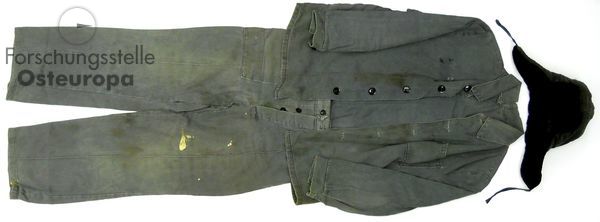Odesa-Tage 2025
Eröffnung globale°-Festival / Kolloquiumsvortrag
19:00, Rathaus Bremen
David Safier (Bremen)
„Die Liebe sucht ein Zimmer“
Anmeldung bis 20.10
globale°-Festival / Kolloquiumsvortrag
18 Uhr (s.t.), Europapunkt, Am Markt 20
Oxana Matiychuk (Tscherniwzi)
Literatur im/vom Krieg. Ein Bericht aus Tscherniwzi
Conference: Coming to the Surface or Going Underground? Art Practices, Actors, and Lifestyles in the Soviet Union of the 1950s-1970s
Research Centre for East European Studies (FSO)
Registration until 07.11.2025
Wissenswertes
Lev Timofeyev’s prison clothing
CORRECTION
Further research revealed that the depicted prison clothing was wrongly associated to Lev Timofeyev. It was in fact worn by Georgiy Valentinovich Davydov, who will be the subject of an upcoming article. We apologize sincerely for the confusion.
When he came home from his work at the Komsomol’s Journal Young Communist one evening in Spring 1976, Lev Mikhailovich Timofeyev found his wife in a state of shock and excitement. Natalya had just made the acquaintance of a neighbor, who had locked herself out of her apartment by mistake. The young woman, named Gyuzel, had accepted her invitation to take a cup of tea. However, in the course of the conversation, she unexpectedly revealed that she was the wife of the famous dissident Andrey Amalrik and that the two of them were hiding, expecting to be expelled from the country any day. Hardly knowing what she was doing, Natalya asked Gyuzel to introduce her husband to Amalrik. When Timofeyev found out about the encounter, his first reaction was to back off in fear.
Although Timofeyev held dissenting views, he had always tried to act within the framework of the system: a published writer, he had become a freelance journalist in 1963 and had joined the staff of Young Communist in 1973. After unsuccessfully trying to publish his independent research entitled The Technology of the Black Market, he had recently become a candidate party member, hoping to increase his chances of seeing his work appear in print. He had no desire whatsoever to become a dissident. Nor did he consider publishing his work in the West. Yet after a great deal of hesitation, he accepted the invitation to meet Amalrik, and this constituted his first step on the path of dissent.
Through Amalrik, Timofeyev read for the first time The Gulag Archipelago, which had a deep impact on him, and made the acquaintance of Yuri Orlov, who had recently formed a Moscow Helsinki Group. He also became connected with Russian nationalist dissidents Igor Shafaryevich and Igor Khokhlushkin. The latter sent to the West Timofeyev’s manuscript, which had been circulating in samizdat. Timofeyev, who had studied economics and had worked a few years in the field of foreign trade in his youth, identified in his pioneering study that the black market represented the basis of the Soviet economy. As he examined the mechanisms of the Soviet shadow economy, Timofeyev also denounced the exploitation of peasants by the Soviet system. He provokingly asked: “What is the mechanism of exploitation of a worker in conditions of developed socialism?” Technology of the black market first appeared in the tamizdat journal Russian Renaissance in 1980-1981, with a book edition in Russian in 1982 and translations into Italian (1983) and English (1985: Soviet Peasant: or the peasants’ art of starving). It was also widely broadcasted on “Radio Liberty” and “Voice of America.” From 1980 to 1985, Timofeyev authored several other literary works, which appeared without his consent in the West.
These publications were incriminated to him when he was arrested in March 1985. Accused of “anti-Soviet agitation and propaganda,” Timofeyev refused to collaborate with the investigators, and was ultimately condemned to six years of camp and five years of internal exile. Sent to the camp “Perm 36” after nine months of pre-trial detention at the Lefortovo prison, he eventually spent just over a year in the Urals camp and was liberated with the amnesty of political prisoners in February 1987. Thereafter, Timofeyev resumed his public activities, co-founding the informal journals Glasnost’ and Referendum and becoming a co-chair of the Moscow Helsinki Group, which resumed its activities at the initiative of Timofeyev and other human-rights activists in 1989. In 1996, Timofeyev became head of a laboratory for the study of illegal economic activity at the Russian State University for the Humanities.
Further reading:
Lev Timofeyev: “Moi vnutrennyy tsenzor byl ubit chteniem ‘Arkhipelaga Gulag’,” in Gleb Morev (ed.): Dissidenty. Dvadtsat Razgovorov. Moscow 2017.
Lev Timofeyev: Tekhnologiya chernogo rynka ili krestyanskoe isskustvo golodat, Bayville (N.J.) 1982.
Barbara Martin wrote her PhD about dissidence in the Soviet Union and worked several times at the Research Center for East European Studies, most recently in 2018. In her new project she is currently analyzing the Russian Orthodox Intelligentsiya in the late Soviet Union.
Länder-Analysen
» Länder-Analysen
» Eastern Europe - Analytical Digests
Discuss Data
Archiving, sharing and discussing research data on Eastern Europe, South Caucasus and Central AsiaOnline-Dossiers zu
» Erdgashandel
» Hier spricht das Archiv
» Russian street art against war
» Dissens in der UdSSR
» Duma-Debatten
» 20 Jahre Putin
» Protest in Russland
» Annexion der Krim
» sowjetischem Truppenabzug aus der DDR
» Mauerfall 1989


